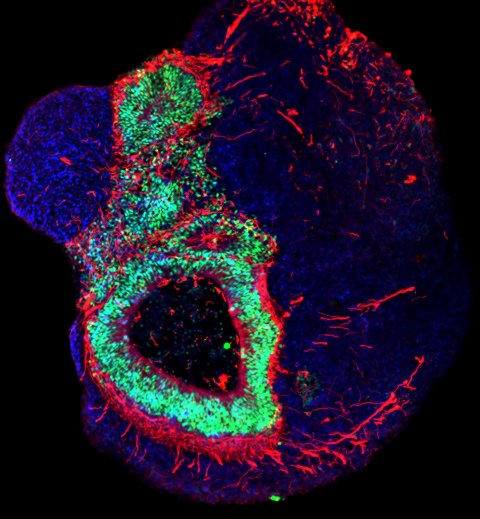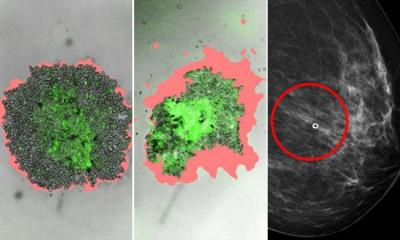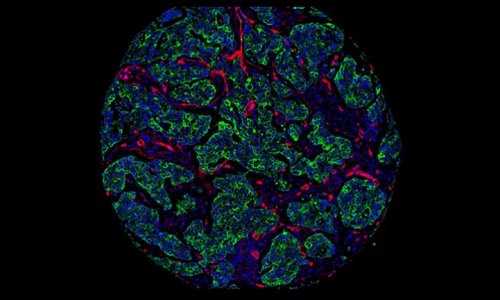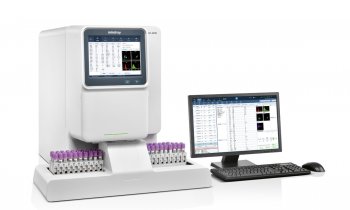News • Precision medicine
Europe looks to cells for a healthier future
How can we detect the first signs of disease as early as possible? Could closer investigation at the cellular level help to quickly prevent disease progression through appropriate treatment?
© Agnieszka Rybak-Wolf, MDC
The European Union is now investing a million euros over a one-year period to devise the plan for a fundamentally new approach to understanding the constant changes within cells and their relationships to one another, thus creating the foundation for the precision medicines of the future. These funds will go to the international LifeTime consortium, which is jointly coordinated by the Max Delbrück Center for Molecular Medicine (MDC) and the Institut Curie.
The two largest European research organizations – Germany’s Helmholtz Association and the National Centre for Scientific Research (CNRS) in France – are playing a major role in the project. More than 120 scientists at 53 institutions in 18 European countries are supporting the LifeTime consortium, as are more than 60 partners from industry. The European Union will concurrently fund the preparation of five other potential research initiatives. After the first year of funding, it will be up to the European Union to decide if any of them will be continued as a large-scale research initiative.
Enhancing precision of therapeutic strategies
If a 58-year-old woman experiences a heart attack, there is currently only one option available to her. Physicians will use a cardiac catheter to look for obstructed or narrowed blood vessels and then treat her according to textbook protocols. The procedure might look different in the future: Physicians first take a tiny sample at the site of the heart attack. They then sequence the RNA which is expressed there by the DNA in individual cells, thereby identifying the cell aggregates that have become inflamed and that can either heal the aftereffects of the heart attack or cause additional damage.
What is crucial here is the development of innovative technologies that enable scientists to not only analyze cell populations, but also study individual cells in detail. Data gathered this way can be used by physicians to design precise therapeutic strategies. This vision of precision medicine cannot be realized by only gathering human behavioral data from smartphones and wearable microcomputers – so-called wearables. Instead, it requires an understanding of how individual cells in our body change over time. That is because cells are not static components, but rather dynamic units that undergo constant transformation. Even when we are healthy, our cells develop and multiply, form tissues with numerous other cells, acquire new characteristics, or simply age all the time. Such change can be a normal development or lay the foundation for disease. Cells are especially prone to change over the course of the disease process.
Unlocking the future: single-cell biology, organoids, and AI

© Agnieszka Rybak-Wolf, MDC
LifeTime’s research teams bring together cutting-edge technologies and by collaborating within the project and they can significantly push forward their development in Europe. For example, miniature organs grown in the petri dish – so-called organoids – and other innovative system such as new single-cell biology techniques – recently selected as Science’s breakthrough of 2018 – play a crucial role here. The organoids derived from patients’ stem cells enable the development of personalized disease models. Combined with the genome editing tool CRISPR, as well as state-of-the-art microscopy, and other models they will help scientists understand how cells stay healthy or progress towards disease and react to therapeutics.
The experiments – performed using high-throughput methods – generate huge amounts of data. Machine learning and artificial intelligence are therefore required for the analysis. The computational strategies identify patterns in the transformation of cells and can, for example, predict the onset of a disease or how a disease will progress. Together with mathematical models that enable the reconstruction of the cells’ past development, it is thus possible to infer how healthy cells become unhealthy cells. The scientists are also searching for central controls that can reverse or even completely prevent disease-causing changes.
This interdisciplinary and international cooperation has the potential to raise health research, and thus medical care to a new level
Otmar D. Wiestler
The proposed groundbreaking initiative brings together not only researchers from the fields of biology, physics, computer science, mathematics, and medicine, but also experts from disciplines such as sociology, ethics, and economics. LifeTime researchers plan to include the public in their work by holding consultations early on to collect wider views and opinions on LifeTime and how it can meet the needs of European society. It is anticipated that the LifeTime initiative will significantly impact the pharma, biotech, and data processing industries, as well as other sectors, while also positively influencing Europe’s competitiveness.
More than 60 companies, major European research organizations such as the Helmholtz Association in Germany, the National Centre for Scientific Research (CNRS) in France, the Wellcome Trust in the United Kingdom, the Netherlands Organisation for Scientific Research (NWO), and the EU-LIFE Alliance, as well as several national science academies are already supporting LifeTime. “LifeTime is an outstanding project of European pioneers. This interdisciplinary and international cooperation has the potential to raise health research, and thus medical care to a new level. Therefore, we are very pleased that the EU is financing the LifeTime consortium. LifeTime is in the best sense: research for people," says Otmar D. Wiestler, President of the Helmholtz Association.
A European vision
The consortium will initially receive funding for one year from the EU. During this time it will prepare a detailed plan for a ten-year research initiative. “We want to use single-cell biology to understand how diseases develop, cell by cell, in an organism. That the EU will now support the initiative is wonderful news for the Center,” says Martin Lohse, Scientific Director of the MDC. “This affirms that we’re developing a specialization in a particularly promising area of research – one that can be expected to quickly make its way into clinical medicine.”
“This is a huge opportunity,” says Professor Nikolaus Rajewsky, who heads the MDC’s Berlin Institute for Medical Systems Biology (BIMSB), a hot spot for single-cell analyses. He is one of the two coordinators of the research consortium. “All of LifeTime’s members are among the best in their respective fields. They are doing visionary work. We are going to use this year to intensify our collaboration, share our vision and extend our network within Europe and beyond.” A launch conference will be held in Berlin from May 6 to 7, 2019, where the consortium’s members will introduce LifeTime and share information on how LifeTime plans to strengthen life sciences and healthcare in Europe.
The exact diseases the LifeTime initiative will focus on have yet to be selected. Refining the choice of disease will be a priority and will take into account a multitude of factors: “Europe’s citizens face a wide variety of medical conditions. During the first year, part of the plan is to determine which diseases are most amenable to our emerging technologies and models,” says Geneviève Almouzni, co-coordinator of the project, Research Director at the CNRS and director of the Research Center of the Institut Curie from 2013 to 2018. “We will do this with the aid of citizens, health professionals and policy makers. We foresee, that the diseases could include cancers but also heart diseases, nervous system disorders, or other diseases.”
Source: Max Delbrück Center for Molecular Medicine
16.01.2019











